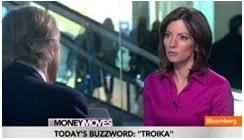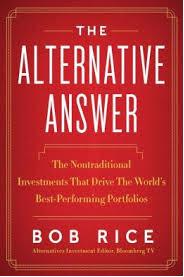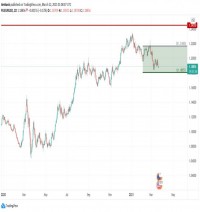|
By Mark Melin 
Bob Rice is author of The Alternative Answer
an easy read that explores intellectually significant topics. After reading north of 30 alternative investing / financial services books (and involved in writing two), it can be said The Alternative Answer is among the easiest reads, but don't let this fool you. The book speaks on several levels and tackles important intellectual topics. At times entertaining, at times it takes complex topics and breaks them down into a logical framework without losing important nuance, and at times it addresses controversial alternative investing topics in a way not previously seen. A good example of explaining a complex investment in an understandable framework is how Mr. Rice, the alternatives editor at Bloomberg TV and managing director at Tangent Capital, describes managed futures. Starting with a simple explanation of the time horizon and variability benefits of the contract structure, he moves into definition of the commonly mis-understood industry nomenclature such as commodity trading advisor, pointing out variables that make the investment somewhat controversial. Then he uncovers the big benefit of performance in over 90% of previous stock market crisis. The author's treatment of other alternative investments can be revealing and to the point. From peer to peer lending ("actually get paid for the credit risk you take") to farmland and timber ("using a good farm management company is the way to go") to convertible arbitrage strategies ("a style that performed spectacularly for many years... but things were downright ugly in the crash"), Mr. Rice not only informs investors but provides needed insight and recommendations. 
Mr. Rice is alternatives editor for Bloomberg TV and managing
director of Tangent Capital Partners. However, before digging into individual investment choices, Mr. Rice recommends first considering the framework to make investment decisions. Logical Framework When investors consider alternatives, rather than start by considering various investment choices or determining the percentage they have in alternatives relative to stocks and bonds, Mr. Rice advises investors to back up a step. On page 51 he organizes investments into categories based on investor need for income, risk reduction, return enhancement and purchase power protection, a strong place to being to understand alternative assets. Only with a determination of investor needs should one move to consideration of investment style, Mr. Rice advises. Liquidity and fees are among the topics upon which the author finds the most passion. "There are rather nice values available to investors willing to accept a degree of illiquidity," he said in an interview, noting the important of investor liquidity calculator methods in the book. "Fees are too high, particularly given funds that were highly correlated to the stock market in 2008." 
Mr. Rice has pointed opinions regarding typical 2/20 fees charged to investors: he doesn't like high fees, particularly when paying for beta rather than alpha. "Fees are too high, particularly given funds that were highly correlated to the stock market in 2008," he said, advocating investors pay low fees for beta products while recognizing alpha when it exists. How the Book Differentiates Itself From Other Alternative Books When compared to the formula-driven, academic work by Mark Anson's Handbook of Alternative Assets (Wiley), The Alternative Answer (Harper-Collins) might be considered more a practitoner's tool in explaining complex investments to investors using a logical and understandable framework. Where Mr. Anson's work might be considered highly technical for an upper level professional / academic audience, Mr. Rice wrote an intellectually credible book that is at times entertaining yet addresses significant issues. When compared to Alternative Investments, a book written by brokerage practitoners Larry Swedroe and Jared Kizer, The Alternative Answer focuses on a more sophisticated audience as it digs deeper into "real" alternatives. Swedroe and Kizer did a strong job covering "mainstream" topics such as stable value funds, fixed annuities, emerging market bonds, but those deep in the alternatives industry might find their lack focus on "real" alternatives as cause for raising questions. For instance, on page 55 authors Swedroe / Kizer inaccurately define managed futures CTAs as "unregulated pools of assets." That couldn't be further from the truth. Managed futures is not only regulated, but for US registered participants performance and business operations offering accounts to the public are audited by the National Futures Association. Mr. Rice makes this important distinction in his book. The first question investors should ask in managed futures is: "Has performance been audited by the National Futures Association?" Liquid, regulated investments should be in focus, and Mr. Rice does a good job in this regard. Mr. Rice does a good job speaking to the innovative RIA or family office consultant who is planning on how to manage a portfolio through a variety of volatility regimes. Tackling Controversial Topics It's educational to see intellectual topics challenged, and Mr. Rice doesn't shy away from controversy. The book tackles controversial topics and some readers, including this reviewer, may take the opposite side of certain opinions. For instance, on page 66 Mr. Rice takes to task Harry Markowitz and his Nobel Prize winning Modern Portfolio Theory (MPT), where he appears to mock the efficient frontier. "And here it is, the sensuous curve that is the egogenous zone of the investment world," he writes, describing Markowitz graphical model for analysis of risk and reward. "If Helen Gurley Brown had edited Barron's instead of Cosmo, it would have been on every cover," he notes with common comic insight surrounding complex topics, including the question: "Why is the line curved and not straight?" (A Markowitz defender might say the curvature is due to differing volatility levels being measured on the Y axis and returns being measured on the X axis. The curvature effect is due to the volatility / returns profile. Volatility doesn't always work in straight lines.) Another serious argument he makes is that past performance cannot be considered a predictor of the future results - and thus giving MPT too much weight might be inappropriate. From a fundamental economic standpoint, past performance might not indicate future results, but will the same be true of market price environments? From a fundamental standpoint, some inside the derivatives industry have noted in a debt crisis future market crashes could look very different from previous crashes. The flash crash is what should be avoided by all accounts. Even thought a flash crash might exhibit price persistence, most managed futures trend followers would likely have difficulty identifying such a quick trend change. That's from a technical standpoint. From a fundamental standpoint, when one considers the great depression, there was a general scarcity of money. It has been said that a debt crisis crash is opposite that of a depression in that the currency will likely be devalued yet plentiful. So yes, past performance doesn't indicate future results. But will there be any point in market history at which trends, volatility and mean reversion disappear? One might assume that if markets remain free, price trends will persist, relative value tables will continue to have divergence / convergence patterns and volatility won't disappear. Thus, is looking at many of the managed futures strategies through the lens of MPT appropriate? (Another pet issue with MPT is the extent to which it assigns the same degree of risk to upside deviation as it downside deviation, an argument first made in 2010. I prefer a quadrant approach.) Mr. Rice analyzes MPT using stocks and accurately notes that past performance and correlations - particularly during crisis - is an entirely different animal ("Strategies based on security prices moving toward their ‘inherent value' simply don't function when the stampede for the door breaks out.") He makes an astute observation that MPT bases assumptions that all market information is assumed to be baked into markets at the same time - and argues this isn't accurate. "The core concept of MPT - that all information is instantaneously and accurately baked into the markets - appears at odds with the real human tendencies to perceive information differently, depending on how, when and to whom it is presented," he writes. Directionless Volatility? Other topics might not be so clear. For instance, Mr. Rice looks into the future and sees volatility but determines this to have potential for directionless volatility. No one can predict the future, but in the past major market volatility has lead to price persistence in nearly 90% of market crisis. Mr. Rice might be correct about the future, as it is yet to unfold. But one wanted the logic for behind the directionless volatility call to have been more precisely explained. But such slight question marks are few and far between. Overall, the book is highly recommended and should be considered as an industry standard tool to explain the alternatives industry landscape. The Alternative Answer covers a wide variety of true alternatives in a clear, concise and practical fashion - and does so with an interesting edge that doesn't back down intellectually. The content will be of interest to investors as well as sophisticated industry practitoners. |
|
This article was published in Opalesque Futures Intelligence.
|





 RSS
RSS











